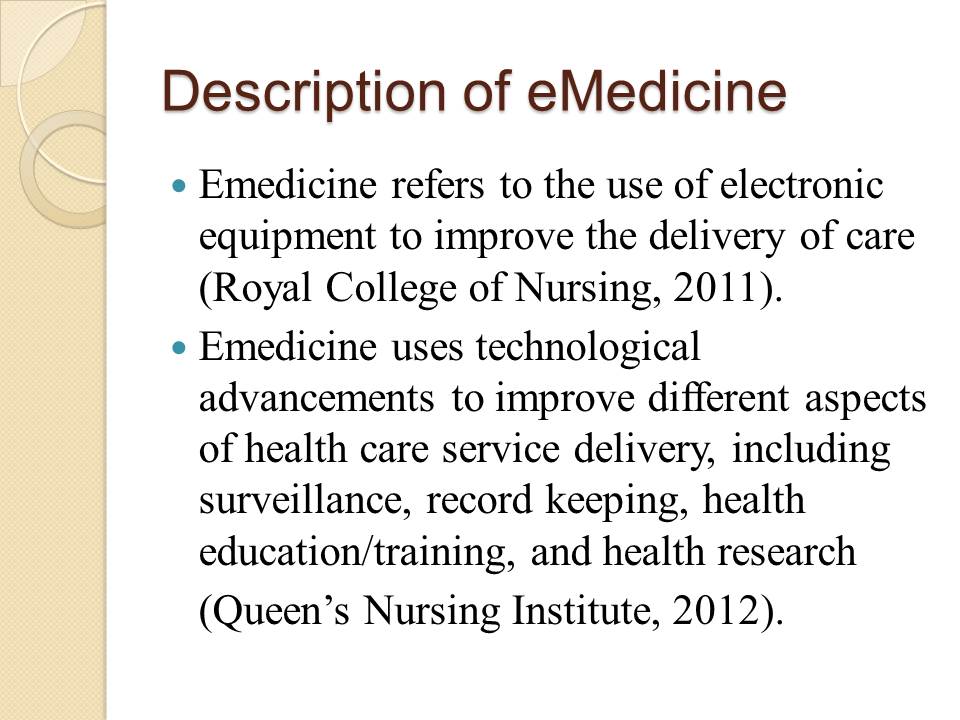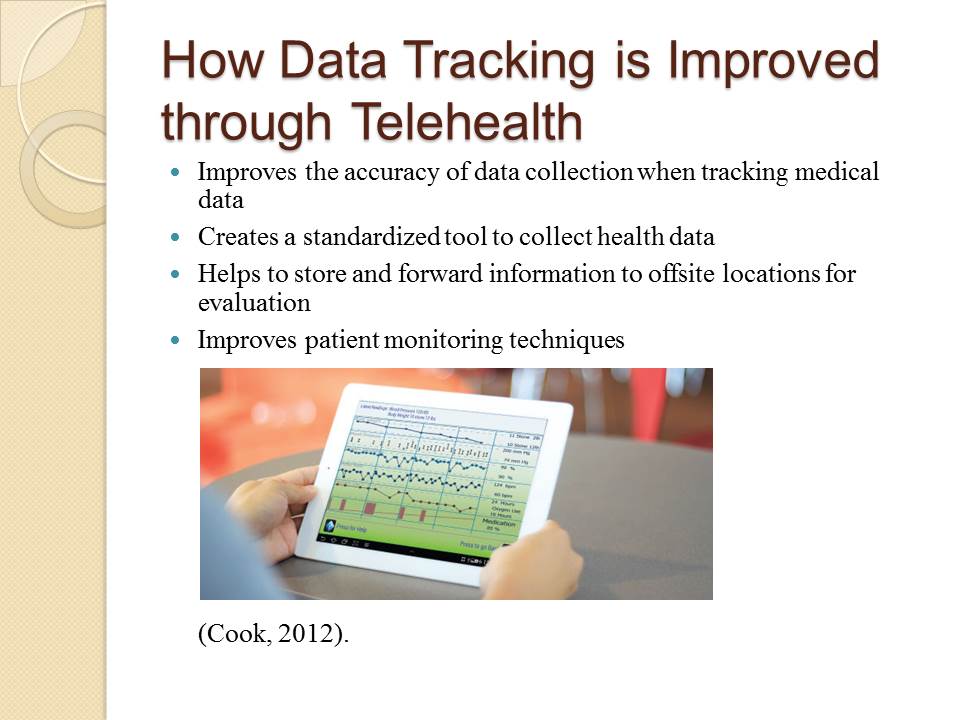Introduction
- Description of eMedicine;
- Description of Telehealth;
- Comparison of Available Models and Systems;
- How Data Tracking is Improved through Telehealth;
- Recommendations to move to Telehealth.
In this paper, I explain the benefits of telehealth by showing how it fits within the wider scope of eMedicine and how its different models and systems help in the improvement of health outcomes. The aim of this presentation is to encourage people to adopt telehealth for the improvement of medical outcomes.

Description of eMedicine
Emedicine refers to the use of electronic equipment to improve the delivery of care (Royal College of Nursing, 2011).
Emedicine uses technological advancements to improve different aspects of health care service delivery, including surveillance, record keeping, health education/training, and health research (Queen’s Nursing Institute, 2012).
Generally, eMedicine involves the application of technology in the delivery of health care services. Different sectors of medicine are affected in this regard. Some of the most commonly affected (improved) areas of health include decision-making, information processing, and records keeping. The eMedicine phenomenon is designed to improve health outcomes, mostly by eliminating human incompetence/mistakes.

Description of Telehealth
Telehealth refers to the use of technological innovations to provide health care services when patients and health care service providers are geographically separated (Vinson, McCallum, Thornlow, Champagne, 2011).
Many people are yet to realize the true potential of telehealth as 77% of the population have had it for less than two years (Brewster, Mountain, Wessels, Kelly, & Hawley, 2013).
Telehealth is an application of eMedicine. It enables the interaction between a patient and a health care professional when both parties are not in the same location. Available technologies in telehealth include live video conferencing, remote-patient monitoring, and mobile health (among others).

Comparison and Contrasting Available Models and Systems
The three models described in this slide explain three different methods that physicians could use to interact with each other and with their patients. The same time/same place model is the traditional model of health care service delivery. The same time/different place model defines current interactive video conference programs. Comparatively, the different time/different place model uses multimedia, internet services for communication. It also uses Teleradiology and store-and-forward techniques to facilitate communication in the health care field.

How Data Tracking is Improved through Telehealth
- Improves the accuracy of data collection when tracking medical data;
- Creates a standardized tool to collect health data;
- Helps to store and forward information to offsite locations for evaluation;
- Improves patient monitoring techniques (Cook, 2012).
Data tracking is improved through telehealth through improved efficiencies in information management. These efficiencies are created through improved monitoring and information processing systems. Indeed, as shown in this slide, telehealth improves the accuracy of data collection and creates a standardized process for collecting data. These are examples of how it improves data tracking and information processing systems.

Recommendations for C.E.O to Move to Telehealth
- Telehealth encourages patient-centered care;
- Improves efficiency in the provision of health care services;
- Improves health care quality;
- Helps to bring health care services to rural communities (Taylor et al., 2015).
Telehealth provides many advantages to stakeholders in the health sector. For example, it simplifies the process of health care service delivery and promotes patient-centered care, which is the guiding principle in health care service delivery. Comprehensively, health administrators should promote its use in the field.

Conclusion
- Problems in telehealth translate to problems in health care. They are not separate;
- Focus on telehealth needs to move away from simply affirming cost-saving advantages to demonstrating the value of investments;
- Newer research is needed to prove the positive outcomes of telehealth.
In this presentation, I have demonstrated the value of telehealth in the medical field. However, my research has revealed that the focus on the adoption of telehealth has only highlighted its financial advantages and neglected expounding on other advantages. New research needs to move away from this focus and demonstrate the holistic value of adopting telehealth. This is the only way that people would understand the immense value of telehealth in the medical field.

References
Brewster, L., Mountain, G., Wessels, B., Kelly, C., & Hawley, M. (2013).
Factors affecting frontline staff acceptance of telehealth technologies: a mixed-method systematic review. Journal of Advanced Nursing, 70(1), 21–33.
Cook, R. (2012). Exploring the benefits and challenges of telehealth. Nursing Times,108(24), 16-17.
Queen’s Nursing Institute. (2012). Smart New World – Using Technology to Help Patients in the Home. London, UK: QNI.
Royal College of Nursing. (2011). eHealth Survey 2010 Report. London, UK: RCN.
Taylor, J., Coates, E., Brewster, L., Mountain, G., Wessels, B., & Hawley, M. (2015). Examining the use of telehealth in community nursing:identifying the factors affecting frontline staff acceptance and telehealth adoption. Journal of Advanced Nursing ,71(2), 326–337.
Vinson, M., McCallum, R., Thornlow, D., Champagne, M. (2011).Design, implementation, and evaluation of population-specific telehealth nursing services. Nursing Economics, 29(5), 265-72.